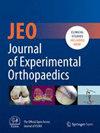Superior long-term stability and function associated with femoral cortical button versus interference screw fixation in ACL reconstruction: A systematic review and meta-analysis
Abstract
Purpose
There are two main methods of femoral graft fixation during anterior cruciate ligament reconstruction (ACLR): cortical button (CB) and interference screws (IS). Each fixation yields its own unique outcomes; however, there is yet to be an established gold standard. We seek to compare femoral CB to IS fixation in ACLR using all soft-tissue, autograft hamstring grafts. We hypothesise that there will be no significant differences between the two methods.
Methods
A systematic review and meta-analysis were conducted following the 2020 PRISMA guidelines. PubMed, Cochrane, Embase, Web of Science and Scopus were screened for potential randomised studies. The studies must have utilised both the semitendinosus and gracilis, and utilised either metallic or bioabsorbable IS, or fixed or adjustable loop CB fixation on femoral fixation. All studies in both groups must have used interference screws on the tibial side. The 2-year follow-up analysed KT-1000 side-to-side differences, while the 5–10 year follow-up compared Lysholm and Tegner scores.
Results
A total of 12 randomised studies were included in the final systematic review, providing an evaluation of 583 distinct patients. Two of the studies were excluded from the meta-analysis, due to not providing pre- and post-operative means and standard deviations. At 2-year and 5-10 year follow-ups, the mean ages were 30.5 ± 8.7 and 30.2 ± 8.1, respectively. Analysis of the 2-year follow-up favour of CB (p = 0.01) in regards to the reduction in KT-1000 side-to-side differences. Analysis of the 5–10 year follow-up revealed favour of CB in regards to the Lysholm Score (p < 0.01), and the Tegner Score (p < 0.01).
Conclusions
At 2-years postoperatively, femoral fixation utilising cortical buttons portrayed less knee laxity than interference screws. At the 5–10 year follow-up, cortical buttons yielded more sports and work-related activity, less pain, and overall greater function than did the interference screws.
Level of Evidence
Level II.




 求助内容:
求助内容: 应助结果提醒方式:
应助结果提醒方式:


